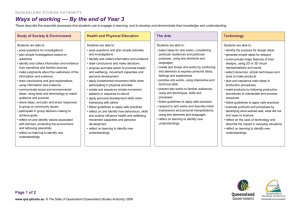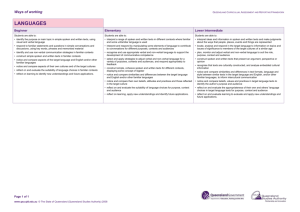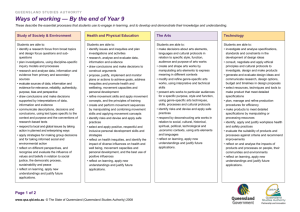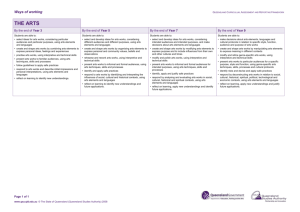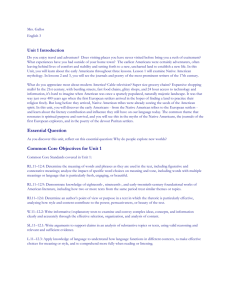DOCX, 48 kB
advertisement
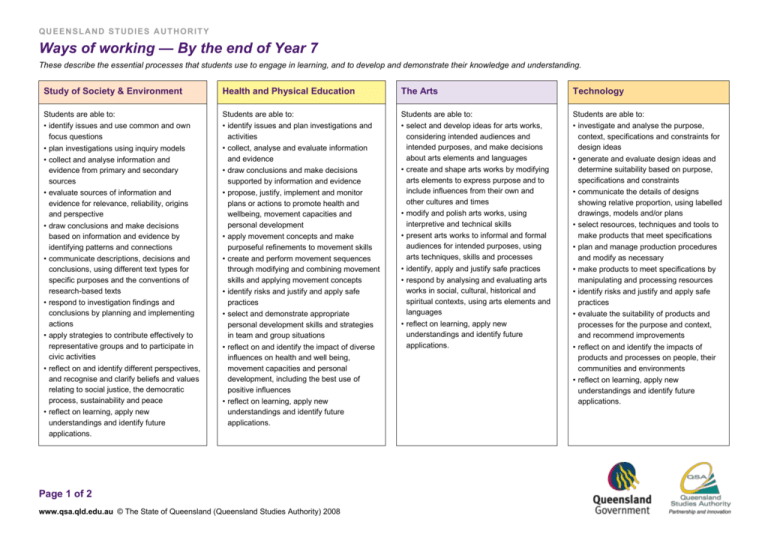
QUEENSLAND STUDIES AUTHORITY Ways of working — By the end of Year 7 These describe the essential processes that students use to engage in learning, and to develop and demonstrate their knowledge and understanding. Study of Society & Environment Health and Physical Education The Arts Technology Students are able to: • identify issues and use common and own focus questions • plan investigations using inquiry models • collect and analyse information and evidence from primary and secondary sources • evaluate sources of information and evidence for relevance, reliability, origins and perspective • draw conclusions and make decisions based on information and evidence by identifying patterns and connections • communicate descriptions, decisions and conclusions, using different text types for specific purposes and the conventions of research-based texts • respond to investigation findings and conclusions by planning and implementing actions • apply strategies to contribute effectively to representative groups and to participate in civic activities • reflect on and identify different perspectives, and recognise and clarify beliefs and values relating to social justice, the democratic process, sustainability and peace • reflect on learning, apply new understandings and identify future applications. Students are able to: • identify issues and plan investigations and activities • collect, analyse and evaluate information and evidence • draw conclusions and make decisions supported by information and evidence • propose, justify, implement and monitor plans or actions to promote health and wellbeing, movement capacities and personal development • apply movement concepts and make purposeful refinements to movement skills • create and perform movement sequences through modifying and combining movement skills and applying movement concepts • identify risks and justify and apply safe practices • select and demonstrate appropriate personal development skills and strategies in team and group situations • reflect on and identify the impact of diverse influences on health and well being, movement capacities and personal development, including the best use of positive influences • reflect on learning, apply new understandings and identify future applications. Students are able to: • select and develop ideas for arts works, considering intended audiences and intended purposes, and make decisions about arts elements and languages • create and shape arts works by modifying arts elements to express purpose and to include influences from their own and other cultures and times • modify and polish arts works, using interpretive and technical skills • present arts works to informal and formal audiences for intended purposes, using arts techniques, skills and processes • identify, apply and justify safe practices • respond by analysing and evaluating arts works in social, cultural, historical and spiritual contexts, using arts elements and languages • reflect on learning, apply new understandings and identify future applications. Students are able to: • investigate and analyse the purpose, context, specifications and constraints for design ideas • generate and evaluate design ideas and determine suitability based on purpose, specifications and constraints • communicate the details of designs showing relative proportion, using labelled drawings, models and/or plans • select resources, techniques and tools to make products that meet specifications • plan and manage production procedures and modify as necessary • make products to meet specifications by manipulating and processing resources • identify risks and justify and apply safe practices • evaluate the suitability of products and processes for the purpose and context, and recommend improvements • reflect on and identify the impacts of products and processes on people, their communities and environments • reflect on learning, apply new understandings and identify future applications. Page 1 of 2 www.qsa.qld.edu.au © The State of Queensland (Queensland Studies Authority) 2008 QUEENSLAND STUDIES AUTHORITY Ways of working — By the end of Year 7 These describe the essential processes that students use to engage in learning, and to develop and demonstrate their knowledge and understanding. Languages Beginner Elementary Lower Intermediate Students are able to: • identify the purpose or main topic in simple spoken and written texts, using visual and verbal language • respond to familiar statements and questions in simple conversations and discussions, using key words, phrases and memorised material • identify and use non-verbal communication strategies in familiar contexts • construct simple spoken and written texts in familiar contexts • notice and compare aspects of the target language and English and/or other familiar languages • notice and compare aspects of their own cultures and of the target cultures • reflect on and evaluate the suitability of language choices in familiar contexts • reflect on learning to identify new understandings and future applications. Students are able to: • interpret a range of spoken and written texts in different contexts where familiar and some unfamiliar language is used • interpret and respond by manipulating some elements of language to contribute to conversations for different purposes, contexts and audiences • recognise and use appropriate verbal and non-verbal language to support the development of communicative competence • select and apply strategies to adjust verbal and nonverbal language for a variety of purposes, contexts and audiences, and respond appropriately to feedback • construct simple, cohesive spoken and written texts for different contexts, displaying some concept of register • notice and compare similarities and differences between the target language and English and/or other familiar languages • notice and compare their own beliefs, attitudes and practices and those reflected in the target culture • reflect on and evaluate the suitability of language choices for purpose, context and audience • reflect on learning, apply new understandings and identify future applications. Students are able to: • interpret ideas and information in spoken and written texts and make judgments about the ways that people, places, events and things are represented • locate, analyse and respond in the target language to information on topics and issues of significance to members of the target cultures of a similar age • plan, monitor and adjust verbal and non-verbal language to suit the role, purpose, context and audience • construct spoken and written texts that present an argument, perspective or opinion • recognise that texts are culturally constructed, and analyse embedded cultural information • notice and compare similarities and differences in text formats, language and style between similar texts in the target language and English, and/or other familiar languages, to inform intercultural communication • notice and compare beliefs, values and practices in target language texts to identify the author’s purpose and audience • reflect on and evaluate the appropriateness of their own and others’ language choices in target language texts for purpose, context and audience • reflect on and evaluate learning to evaluate and apply new understandings and future applications. Page 2 of 2 www.qsa.qld.edu.au © The State of Queensland (Queensland Studies Authority) 2008
